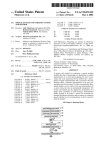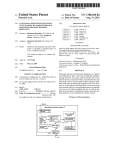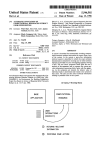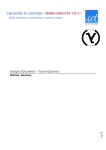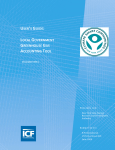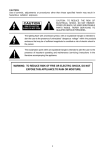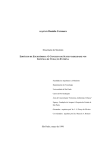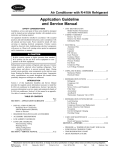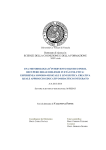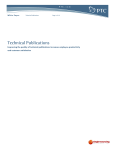Download Speech analysis system and method
Transcript
US006725198B2
(12)
United States Patent
(10) Patent N0.:
US 6,725,198 B2
(45) Date of Patent:
*Apr. 20, 2004
Waryas et al.
(54)
(75)
SPEECH ANALYSIS SYSTEM AND METHOD
5,303,327 A
4/1994 Sturner et al.
5,393,236 A
2/1995 Blackmer et al.
Inventors: Carol Waryas, San Antonio, TX (US);
5,487,671 A
James H. Segapeli, SchertZ, TX (US);
2
.
.
-
7
¥§ga(%';)Splser'Albm’ San Antomo’
_
(73) AsslgneeZ fAlatrco_urtTl;ss(esgl)nent’ Inc->521“
1/1996 ShPiTO ct a1~
1(6);
gen n
,
arre
5,679,001 A
10/1997 Russell et al.
5,717,828 A
2/1998 Rothenberg
5,791,904 A
8/1998 Russell et al.
5,813,862 A
9/1998 MerZenich etal.
n omo,
(List continued on next page.)
(*)
Notice:
Subject to any disclaimer, the term of this
patent is extended or adjusted under 35
U-S-C- 154(1)) by 0 daysThis patent is subject to a terminal disClaimer~
FOREIGN PATENT DOCUMENTS
0 360 909
4/1990
EP
EP
0 504 927
9/1992
EP
WO
1 089 246
99/13446
4/2001
3/1999
OTHER PUBLICATIONS
(21)
Appl. No.: 09/997,204
_
(22) Filed:
NOV- 15, 2001
Jackson, Peter, “Introduction to Expert Systems,” 1999,
Addison Wesley Longman Limited, 3rd Edition, pp.
(65)
Prior Publication Data
207 210'
_
>F
US 2002/0116183 A1 Aug. 22, 2002
,
(List Continued on next Page")
,
Primary Examiner—Richemond Dorvil
Related U'S' Apphcatlon Data
(63)
(51)
(52)
Assistant Examiner—V. Paul Harper
.
.
.
.
.
Continuation-in-part of application No. 09/769,776, ?led on
74) Attorney Agent
( .
’.
. ’
Jan. 25, 2001, and a continuation-in-part of application No.
09/770,093, ?led on Jan. 25, 2001.
Mllbrath & Gllchnst> P'A'
(57)
ABSTRACT
or Firm—Allen
Int. Cl.7 ....................... .. G10L 15/06; G10L 21/06;
’
Dyer
’
Doppelt
’
_
G09B 19/04; G09B 1/00
A system and method for analyzing a speech problem
US. Cl. ..................... .. 704/254- 704/271- 704/276-
includes the Steps of Presenting a Symbol representative of
’ 434/185’. 434/167’
a Word and prompting the user to pronounce the Word
704/276 270
322’ 185’
represented by the symbol into an audio input device such as
a microphone in signal communication With a processor.
’ 157’ 116’
’
Next the therapist enters a phonetic representation of the
user pronunciation into an operator input and storage device,
(58) Field of Search
70
’
(56)
’
’
References Cited
the phonetic representation subsequently downloaded into
the processor. It is then automatically determined Whether an
US. PATENT DOCUMENTS
4 615 680 A
* 10/1986 Tomatis .................... .. 434/157
4,969,194 A
5,142,657 A
error exists in the user pronunciation. If an error exists, the
error is automatically Categorized‘
11/1990 EZaWa et al.
*
8/1992 EZaWa et al. ............. .. 704/276
27 Claims, 5 Drawing Sheets
open professional version of system
100
provide access to database of records
101
provide access to demographic data
select problem speech sound
104
apply no
filter
?
applyfilter to limit set
search database to create record set
102
103
US 6,725,198 B2
Page 2
US. PATENT DOCUMENTS
5,832,441
5,857,173
5,865,626
5,927,988
A
A
A
A
6,009,397 A
6,019,607
6,030,226
6,055,498
6,071,123
6,077,085
6,113,393
A
A
A
A
A
A
11/1998
1/1999
2/1999
7/1999
Aaron et 211.
Beard et al.
Beattie et 211.
Jenkins et 211.
12/1999 Siegel
American Speech—Language—Hearing Association, Tech
nology 2000: Clinical Applications for Speech—Language
Pathology,
http://professional.asha.org/tech
resources/
tech2000/7.htm, pp. 1—7, 1996.
PictureGallery,
http://WWW.psychcorp.com/catalogs/sla/
sla014atpc.htm, pp. 1—2.
2/2000 Jenkins et 211.
2/2000 Hersh
The Childes System, Child Language Data Exchange Sys
4/2000 Neumeyer et 211.
Additional Childes Tools, CHILDES WindoWs Tools, http://
6/2000 Tallal et 211.
6/2000 Parry et 211.
9/2000 Neuhaus
6,471,521 B1 * 10/2002 Dornbush et a1. .......... .. 318/48
6,356,943 B2 * 3/2003 Murray et a1. ............ .. 709/220
OTHER PUBLICATIONS
LocuTour Multimedia, Articulation: Therapy for Oral
tem, http://childes.psy.cmu.edu.
childes.psy.cmu.edu/html/Wintools.html.
SAILS, the Speech Assessment & Interactive Learning
System (SAILS TM) Using SAILS in Clinical Assessment and
Treatment, http://WWW.propeller.net/react/sails2.htm, pp.
1—3.
GFTA—2: Goldman—Fristoe Test of Articulation—2, http://
WWW.agsnet.com/templates/productvieW p.asp?GroupID=
ApraXia, Dysarthria, and Developmental Speech Disorders,
a11750, pp. 1—3.
http://WWW.learningfundamentals.com/products/manuals/
ArticiIiConsiPhonemes.pdf.*
KLPA: Khan—LeWis Phonological Analysis, http://WWW.ag
snet.com/templates/productvieW p.asp?GroupID=a1820, pp.
Parrot SoftWare User’s Manual “Automatic Articulation
1—2.
Analysis 2000,” Parrot Software, Inc.*
Masterson, Julie and Pagan, Frank, “Interactive System for
Phonological Analysis User’s Guide,” pps 41, Harcourt
Bernthal, John E., and Bankson, Nicholas W. (Eds.),Articu
lation and Phonological Disorders, Fourth Edition, Chapter
9, Instrumentation in Clinical Phonology, by Julie J. Master
son, Steven H. Long, and Eugene H. Buder, 1998, pp.
Brace & Compnay, San Antonio, 1993.
Long, Steven H. and Fey, Marc E., “Computerized Pro?ling
User’s Manual,” pps 119, Harcourt Brace & Company, San
Antonio, 1993.
378—406.
* cited by examiner
U.S. Patent
Apr. 20, 2004
Sheet 1 of 5
US 6,725,198 B2
open professional version of system / 100
i
provide access to database of records / 101
i
provide access to demographic data
i
/ 102
/ 103
select problem speech sound
104
apply no
/ 105
apply filter to limit set
W
search database to create record set
101
=
\ 106
"° @
yes
sort set of records into desired sequence / 108
FIG. 1A.
U.S. Patent
Apr. 20, 2004
Sheet 2 0f 5
US 6,725,198 B2
109
ogrsa?gt/ store/ transmit
transmit
,,
-
use personal version of system
select display style
/120
/110
t
111
present record
/
l
112
prompt student for pronunciation /
\l
113
therapist scores pronunciation /
114
hear
word
pronounced
/115
broadcast word
calculate aggregate score
=
J,
116
store current score
l
calculate historical change
i
calculate statistics
F
\119
FIG. 1B.
U.S. Patent
Apr. 20, 2004
Sheet 4 of 5
US 6,725,198 B2
I
select type of analysis
]/501
(§I_0)—>
L
present symbol to user
502
l
prompt user to pronounce word/perform narration 503
l
enter phonetic representation
/504
y
apply dialectical filter
505
506
no
FIG. 3A.
@ @
yes
automatically categorize the error
507
l
if desired, display frequency spectrum
508
509% if desired, broadcast correct pronunciation |
yes
511\{ perform correlation of errors to make diagnosis]
512
\[
513‘
514
\l
515%
516 \{
issue lreport
J
l
save error in database
I
l
determine
change
overtime
l
issue report
+
recommend therapeutic
program
“1
I
_]
FIG. 3B.
U.S. Patent
Apr. 20, 2004
Sheet 5 of 5
US 6,725,198 B2
501 510
present symbol to user on display
/502’
in communication with processor
. /5o3
prompt user to pronouncel word/ perform narration
l
enter phonetic representation into
separate input device
i
download entered phonetic
representation into processor
FIG. 4.
12\
student
10\
system
47\ operator input and storage device
11\
therapist
FIG. 5.
/520
/521
US 6,725,198 B2
1
2
SPEECH ANALYSIS SYSTEM AND METHOD
ogy (American Guidance Service), Photo Articulation Test
(Pro-Ed), and Fisher-Logeman Test of Articulation (Pro-Ed).
CROSS-REFERENCE TO RELATED
APPLICATION
SUMMARY OF THE INVENTION
It is therefore an object of the present invention to provide
This application is a continuation-in-part of and claims
priority to application Ser. No. 09/769,776, entitled “Speech
Analysis and Therapy System and Method,” ?led Jan. 25,
2001, and application Ser. No. 09/770,093, entitled “Speech
Therapy System and Method,” ?led Jan. 25, 2001, Which are
commonly oWned With the instant application and Which are
a system and method for eliciting a desired sound from a
user.
10
incorporated herein by reference.
BACKGROUND OF THE INVENTION
1. Field of the Invention
The present invention relates to systems and methods for
15
analyzing and remediating speech pathologies, and, more
particularly, to such systems and methods that are computer
based.
2. Description of Related Art
20
system for providing speech therapy. The method comprises
Articulation and phonology disorders are the most com
mon of the speech and language disorders. The prevalence
of this disorder is, at the time of Writing, approximately 10%
of the school-age population. In addressing a perceived
articulation issue in a student, speech/language pathologists
the steps of selecting a problem speech sound and searching
25
have in the past used an initial test based upon a series of
cards. Each card contains a picture and a Word, and the
student is asked to pronounce the Word associated With the
card. The pathologist then determines Whether the student’s
pronunciation is “right” or “Wrong.” It may be recogniZed
It is a further object to provide such a system and method
adapted to generate a report.
It is another object to provide a system and method for
testing a user’s articulation.
It is an additional object to provide such a system and
method that is adapted to analyZe a group of problematic
sounds.
It is yet a further object to provide such a system and
method that recommends a therapeutic program responsive
to the analysis.
It is yet another object to provide such a system and
method that includes a prescreening feature.
These and other objects are achieved by the present
invention, a ?rst aspect of Which comprises a method and
30
a database that comprises a plurality of records. Each record
comprises a picture and a Word associated With the Word.
Next a set of records is automatically generated from the
plurality of records. Each record contains a Word speci?c to
the problem speech’s sound. The set of records is next
automatically presented to a user sequentially on a display
device, and the user is prompted to pronounce the displayed
that such a system can be cumbersome, oWing to the cards’
Word. Finally, the pronunciation of each Word is scored.
The system of the ?rst aspect of the present invention
having to be placed in a desired order and sorted manually.
An intervention system designed to automate this process,
Picture Gallery I, Was presented by the oWner of the current
application. In this system pictures and/or Words stored in a
comprises a processor, an input device in communication
With the processor having means for selecting a problem
speech sound, and a display device in communication With
35
the processor. The database as described above is resident on
database could be sorted using a desired criterion such as a
the processor, as are softWare means. The softWare is
particular phoneme and presented to the student under
adapted to automatically generate a set of records from the
plurality of records, With each record containing a Word
speci?c to the problem speech sound. The softWare is also
adapted to automatically present at least a portion of each
softWare control for facilitating the acquisition or remedia
tion of speech or language skills. No analysis or scoring is
performed; rather, the product is intended for use by one or
40
more students, either alone or in concert With a pathologist/
teacher.
Apreviously knoWn method of diagnosing articulation or
phonology disorders included a “pencil and paper” test
Wherein a student is asked to speak a Word. The therapist
record in the set of records to a user sequentially on a display
device; the set of records to a user sequentially on the
display device and to prompt the user to pronounce the
45
grades the Word subjectively, based upon the therapist’s ear
and the local standards.
Other systems knoWn in the art that address speech/
language analysis and therapy methodologies includes those
of Neuhaus (US. Pat. No. 6,113,393), Parry et al. (US. Pat.
No. 6,077,085), UCSF and Rutgers (US. Pat. Nos. 5,813,
862 and 6,071,123), Neumeyer et al. (US. Pat. No. 6,055,
498), Jenkins et al. (US. Pat. Nos. 5,927,988 and 6,019,
607), Siegel (US. Pat. No. 6,009,397), Beard et al. (US. Pat.
No. 5,857,173), Aaron et al. (US. Pat. No. 5,832,441),
Russell et al. (US. Pat. Nos. 5,679,001 and 5,791,904),
Rothenberg (US. Pat. No. 5,717,828), Wen (US. Pat. No.
5,562,453), EZaWa et al. (US. Pat. No. 4,969,194), Sturner
et al. (US. Pat. No. 5,303,327), Shpiro (US. Pat. No.
displayed Word. Finally, the softWare is adapted to receive
via the input device a score for the pronunciation of each
Word.
Another aspect of the present invention is a system and
50
method for analyZing a speech problem by performing a test
of articulation, phonology, and sound features that is admin
istered and analyZed With the use of an electronic processor.
This method comprises the steps of presenting to a student/
user a symbol representative of a Word and prompting the
user to pronounce the Word represented by the symbol into
55
a microphone in signal communication With a processor.
Next the therapist enters a phonetic representation of the
user pronunciation into the processor. It is then automati
cally determined Whether an error exists in the user pronun
ciation. If an error exists, the error is automatically catego
5,766,015), and Siegel (US. Pat. No. 6,148,286). Commer
riZed.
In an alternate embodiment of the method, the therapist
cial softWare products in the ?eld of articulation, phonology,
or speech sound production include Speech VieWer, Inter
enters the phonetic representation of the user pronunciation
into an input and storage device that is not in signal
active System for Phonological Analysis, Speech Master,
Visi-pitch, and ComputeriZed Pro?ling. Commercial print
60
communication With the processor. At a later time the
65
phonetic representation is doWnloaded into the processor,
products include the Goldman-Fristoe Test of Articulation
Whereupon the automatic determining and categoriZing
(American Guidance Service), Khan-Lewis Test of Phonol
steps proceed.
US 6,725,198 B2
4
3
The system of the second aspect of the invention evalu
and method are also contemplated for use in the acquisition
ates an articulation disorder. The system comprises a pro
cessor and an output device and an input device, each in
of a language skill as Well as in a remediation setting. There
signal communication With the processor.
sional” version 10 of the invention (block 100), typically
are tWo versions of the system and method: In the “profes
tWo people Who Will be referred to as “therapist” 11 and
Software installable on the processor is adapted to present
on the output device, typically a display device, although
“student” 12 are present, although this is not intended as a
this is not intended as a limitation, a symbol representative
of a Word. The softWare then is adapted to prompt a user via
settings 32 as a hospital, clinic, rehabilitation center, school,
or private facility. In the “personal” version 40 of the
invention, the “student” 12 may be Working alone, or in the
the output device to pronounce the Word represented by the
symbol and to receive from the therapist via the input device
a phonetic representation of the user’s pronunciation. The
limitation. This version is contemplated for use in such
10
11 may be, for example, a speech therapist or a teacher; the
softWare automatically determines Whether an error exists in
the user pronunciation, and, if an error exists, automatically
categorizes the error.
In the alternate embodiment the system comprises a
processor and an output device and a user input device, each
student 12 may be a user Who is learning a second language
or a school attendee Who is being tested for, or Who is
15
101). Each record comprises a Word, a picture representative
of the Word, and a recommended pronunciation of the Word.
In an alternate embodiment, the record may also include a
thereinto, the data comprising the phonetic representation.
digitiZed video clip to represent motion or a verb to impart
a concept of action. In another embodiment the record may
further include a digitiZed sound that is associated With the
The softWare then receives doWnloaded data from the
operator input and storage device the phonetic representa
tion of the user’s pronunciation. The softWare automatically
already knoWn to have, an articulation problem or phono
logical disorder.
The method comprises the steps of providing access to an
electronic database that includes a plurality of records (block
in signal communication With the processor. The system
further comprises an operator input and storage device that
is not in signal communication With the processor, but is
connectable thereto for doWnloading operator-entered data
determines Whether an error exists in the user pronunciation,
presence of a nonprofessional such as a parent. The therapist
25
and, if an error exists, automatically categoriZes the error.
The system and method of this second feature of the
Word. For example, the record for the Word dog might
contain a picture of a dog, a video clip of a dog running,
and/or a barking sound. It is believed that such multiple
stimuli appeal to a multiplicity of cognitive areas, thereby
invention may be adapted for presentation of a single Word,
a plurality of Words having a predetermined feature desired
to be tested, a pretest for screening for potential articulation
optimiZing the student’s improvement.
disorders, and an analysis of connected speech With the use
of a moving picture to elicit a narrative from the student.
The features that characteriZe the invention, both as to
concept. An exemplary set of categories comprises: animals,
organiZation and method of operation, together With further
objects and advantages thereof, Will be better understood
from the folloWing description used in conjunction With the
accompanying draWing. It is to be expressly understood that
Each record may further contain data useful for perform
ing sorting functions, such as at least one category and/or
35
symbols, sports, technical, vacations, and Work. An exem
plary set of concepts comprises: activities, objects, places,
people, ideas, and events. The record also typically com
prises a vocabulary level associated With the Word and a
length of the Word.
The method next comprises the step of inputting or
the draWing is for the purpose of illustration and description
and is not intended as a de?nition of the limits of the
invention. These and other objects attained, and advantages
offered, by the present invention Will become more fully
accessing previously input demographic information for the
student (block 102). Then a problem speech sound that is
apparent as the description that noW folloWs is read in
desired to be improved upon is selected that is knoWn from
conjunction With the accompanying draWing.
45
a prior diagnosis (block 103).
The problem speech sound may be selected from a group
BRIEF DESCRIPTION OF THE DRAWINGS
consisting of a phoneme and a “feature.” The feature com
prises at least one of a place, a manner, and a voicing
characteristic. Searching on a feature yields matches in all
FIGS. 1A, 1B is a flow chart for an exemplary embodi
ment of the speech therapy method of the invention.
FIG. 2 is a schematic diagram of the speech therapy
positions of Words. The database is electronically searched
(block 106) for records containing Words that include the
system.
problem speech sound to generate a set of records. A ?lter
FIGS. 3A, 3B is a flow chart for an exemplary embodi
may be applied if desired (block 104) to further limit the set
ment of the speech analysis method of the invention.
(block 105), including selecting a category or concept, using
FIG. 4 is a section of a flow chart for another embodiment
of the speech analysis method of the invention.
art, babies, celebrations, global images, environment,
family, food, garden, health and exercise, home, leisure,
medical, money, music, pets, play, school, shopping, signs/
55
FIG. 5 is a schematic diagram of an alternate embodiment
the demographic information to limit the set, such as elimi
nating Words that are intended for students over 7 years of
mated speech therapy/intervention method is given in FIGS.
age for a 5-year-old student, setting a desired vocabulary
level, or selecting a Word length.
If desired (block 107), the set of records may also be
sorted (block 108) in various Ways to produce a desired
sequence, including, but not limited to, putting the Words in
alphabetical order, random order, or some other chosen
sequence. In a preferred embodiment, all the Words in the
database contain at least one of the letters “r,” “l,” and “s,”
since these are knoWn to present a problem most frequently.
For a professional therapy session, a decision may be
1A, 1B, and a schematic of the system in FIG. 2. The system
made Whether to present the set of records or store/transmit
of the speech analysis system.
DETAILED DESCRIPTION OF THE
PREFERRED EMBODIMENTS
Adescription of the preferred embodiments of the present
invention Will noW be presented With reference to FIGS.
1A—5.
A flow chart of an exemplary embodiment of the auto
65
US 6,725,198 B2
5
6
them (block 109). If the former, the set of records is next
presented sequentially to the student in the predetermined
sequence on a display device (block 111), and the student is
processor 41, input device 42 and display device 43 in
communication With the processor 41, and either or both of
a modem 44 for receiving a set of records and a storage
device reader 45 for reading a stored set of records. The
prompted to pronounce the Word (block 112). The display
style may be selected (block 110) from a Word only, a picture
softWare package 46 for this version is adapted to read the
records, present them to the student 12 sequentially, and
only, or a Word plus a picture.
If the student can read, he or she can use the displayed
prompt the student 12 to pronounce the Word associated With
the record.
A How chart of an exemplary embodiment of the auto
Word to form a pronunciation; if the student cannot yet read,
or cannot read the currently presented language, the picture
Will also aid in acquisition of reading skills as Well as
pronunciation.
10
In the professional setting, the therapist scores the stu
mated speech therapy/intervention method is given in FIGS.
3A, 3B. The schematic of the system is substantially the
same as that in FIG. 2. The method comprises the steps of
dent’s pronunciation (block 113) by inputting, for eXample,
“correct,” “incorrect,” “skip,” or “re-present,” Which Will
selecting the type of evaluation desired to be performed
to hear the Word pronounced (block 115) in a recommended
sentative of a Word (block 502) and prompting the user to
pronounce the Word represented by the symbol into a
microphone in signal communication With a processor
(block 501): screening, single Word analysis, “deep” test, or
record an indication to re-present the record at a later time,
15 connected speech analysis. The screening, or pre-evaluation,
such as after all the other items in the set have been
comprises the steps of presenting to a user a symbol repre
presented. The student or therapist can also elect (block 114)
manner by making an appropriate selection on an input
device.
The scores are received by the system, and an aggregate
(block 503). The symbol presentation may comprise, for
score is calculated (block 116) for the problem speech
eXample, a picture on a display screen, although this is not
sound. The database also comprises a historical record of all
sessions for each of the students, and the database is then
accessed to store the current score thereinto (block 117). The
(block 504).
intended as a limitation. The therapist then enters a phonetic
representation of the user pronunciation into the processor
In an alternate embodiment of the method, the altered
therapist may choose to calculate a historical change (block
118) from previously saved scores to provide an indication
portion of Which is illustrated in FIG. 4, the therapist enters
the phonetic representation of the user pronunciation into a
separate operator input and storage device 47, such as, but
not intended to be limited to, a personal data assistant (block
of the student’s progress. Such scores may also be used to
calculate statistics (block 119) for a group of students, using,
for eXample, a demographic ?lter.
The “personal version” of the system and method does not
520). At a later time, the user pronunciation data are doWn
loaded into the processor (block 521) to complete the steps
accept scoring, nor is there a database from Which sets of
of the method.
records may be created. Rather, the professional version is
A schematic of the system (FIG. 5) illustrates the addition
adapted to doWnload a selected set of records onto a storage
medium, such as a diskette, or to transmit the set of records 35 of the operator input and storage device 47, Which is
connectable to the system 10 When desired for doWnloading
to a remote site (block 109). Such a remote site may
data into the processor 14 that has been entered thereinto by
comprise, but is not intended to be limited to, a room remote
the therapist 11.
from the main processor accessible via intranet, or a differ
ent building accessible via internet. This version then
The advantages of this embodiment include the user and
enables the student to perform (block 120) the steps in
the operator being able to use separate pieces of hardWare,
blocks 110—112 and 115 as desired on his or her oWn.
thereby eliminating physical restraints imposed by attempt
comprises a processor 14, on Which are resident the softWare
ing to share equipment. Further, during the session the user
cannot vieW the operator’s scoring information, Which may
package 15 of the present invention adapted to perform the
inhibit the user. In addition, the operator’s hardWare may
The system 10, as schematically illustrated in FIG. 2,
functions as outlined above and a database 16 comprising 45 retain data for doWnloading into more than one processor if
the plurality of records 17 and demographic and historical
desired for subsequent collection and analysis.
data on the users 12. An input device is in communication
With the processor 14 that has means for selecting a problem
processor then automatically determines Whether an error
speech sound. Such means may comprise any of the devices
eXists in the user pronunciation (block 506). The determi
knoWn in the art such as a keyboard 18 or pointing device
nation may additionally include the application of a dialec
In both embodiments, the softWare installed upon the
such as a mouse 19 or touch screen. A display device such
tical ?lter (block 505) that is adapted to discriminate
as a display screen 20 is also in communication With the
betWeen that Which is deemed to be a true error and a
processor 14.
Optional elements that are also in communication With the
processor 14 may include a microphone 21 and a speaker 22,
predetermined normal dialect Word pronunciation. If an
error eXists, the softWare automatically categoriZes the error
(block 507). An error may be, for eXample, a substitution, a
55
performing analog-to-digital 23 and digital-to-analog 24
mispronunciation, or an omission. These steps are repeated
a predetermined number of times n, for eXample, 20 times
conversions. The system 10 also has means for transferring
(block 510).
records from the database to a storage medium such as a disk
drive 25, under control of the softWare 15, or to a remote site
such as another location 26 via a modem 27 over the internet
It may then be desired to perform the “deep test,” Which
may be performed With the knoWledge gained from a
both under processor 14 control, as Well as means for
pre-evaluation as above or de novo. If the pre-evaluation has
28 or such as another room 29 at the same location via an
been performed, the softWare automatically generates a set
of symbols, Wherein each symbol is representative of a Word
intranet 30. Aprinter 31 under processor control may also be
provided for furnishing a hard copy of any portion of the
session as desired.
A secondary system 40 for use of the personal version of
the invention at the remote location 26, 29 comprises a
containing at least one of the errors determined in the
65
pre-evaluation. Then the steps as above are performed using
the generated set of symbols, and an evaluation is made of
articulation errors for the Whole set.
US 6,725,198 B2
8
7
transferring the phonetic representation from the input
If a single Word is desired to be analyzed for, the steps in
blocks 502—509 are performed once for the desired Word.
and storage device to the processor;
automatically determining Whether an error eXists in the
user pronunciation; and
if an error eXists, automatically categoriZing the error.
Once a Word has been pronounced and the phonetic
representation entered into the processor, the therapist may
decide to display a frequency spectrum of the user’s pro
nunciation (block 508). If desired, a sample of a correct
pronunciation of the Word may be broadcast via a speaker in
2. The method recited in claim 1, further comprising the
step, folloWing the prompting step, of displaying a fre
quency spectrum of the user pronunciation.
3. The method recited in claim 1, further comprising the
signal communication With the processor (block 509).
When a plurality of Words have been tested, the evaluat
ing step also comprises automatically recognizing an under
lying commonality by correlating the errors detected. This
10
of a correct pronunciation of the Word.
4. The method recited in claim 1, further comprising the
pattern recognition permits the softWare to achieve an over
step of issuing a report on an error in user pronunciation.
arching diagnosis of a problem speech sound (block 511).
FolloWing the error categoriZation, if desired, a report can
be issued detailing the user’s error(s) (block 512).
step, folloWing the prompting step, of broadcasting a sample
15
Additionally, the error may be saved in a database that is
accessible by the processor (block 513). If a previous entry
for this user already eXists, Which is determined by a search,
the error found in the present test may be compared With an
error previously found, and a change overtime determined
for that user (block 514), to note Whether an improvement
has occurred. Again, if desired, a report may be issued
(block 515) as to the change determined.
5. The method recited in claim 1, further comprising the
steps of:
saving the error in a database accessible by the processor;
searching the database to determine Whether a previous
entry for the user eXists; and
if a previous entry eXists, comparing the error With an
error in the previous entry and determining a change
With time.
6. The method recited in claim 5, further comprising the
step of issuing a report on the determined change.
7. The method recited in claim 1, further comprising the
step, if an error eXists, of recommending a therapeutic
An additional feature of this invention is the ability, once
a categoriZation has been made of an error, of recommend 25 program to address the error.
ing a therapeutic program to address the error (block 516).
8. The method recited in claim 7, Wherein the program
Such a recommendation formulation may comprise, for
eXample, creating a set of records as detailed above in FIGS.
1A—2.
recommending step comprises the steps of:
searching a database comprising a plurality of records,
each record comprising a picture and a Word associated
If connected speech analysis is desired to be performed,
the “symbol” comprises a motion picture representative of
thereWith; and
an action, and the user is prompted to provide a narration on
the action into a microphone in signal communication With
a processor. The therapist then enters a phonetic represen
tation of the user’s pronunciation of the narration into the
processor. SoftWare resident in the processor automatically
35
ciation by the user.
9. The method recited in claim 1, Wherein the presenting
determines Whether an error exists in the user pronunciation,
step comprises displaying a picture on a display screen.
10. The method recited in claim 1, Wherein the error is
and, if an error eXists, automatically categoriZes the error.
It may be appreciated by one skilled in the art that
additional embodiments may be contemplated, including
alternate forms of presentation of the symbols and sounds.
In the foregoing description, certain terms have been used
for brevity, clarity, and understanding, but no unnecessary
limitations are to be implied therefrom beyond the require
ments of the prior art, because such Words are used for
description purposes herein and are intended to be broadly
selected from a group consisting of a substitution, a
mispronunciation, and an omission.
11. The method recited in claim 1, Wherein the determin
ing step comprises applying a dialectical ?lter adapted to
discriminate betWeen an error and a predetermined normal
45
12. A method for evaluating an articulation disorder
(a) presenting to a user a symbol representative of a
the scope of the invention is not limited to the eXact details
of construction.
Word;
(b) prompting the user to pronounce the Word repre
Having noW described the invention, the construction, the
operation and use of preferred embodiment thereof, and the
advantageous neW and useful results obtained thereby, the
sented by the symbol into a microphone in signal
communication With a processor;
55
forth in the appended claims.
(d) transferring the phonetic representation to the pro
cessor;
prising the steps of:
(e) automatically determining Whether an error eXists in
the user pronunciation; and
(f) if an error eXists, automatically categoriZing the
error; repeating steps (a)—(f) a predetermined num
ber of times;
presenting to a user a symbol representative of a Word;
prompting the user to pronounce the Word represented by
the symbol into a microphone in signal communication
With a processor;
tion of the Word into an input and storage device not in
signal communication With the processor;
(c) entering a phonetic representation of the user pro
nunciation of the Word into an input and storage
device not in signal communication With the proces
sor;
What is claimed is:
1. A method for evaluating an articulation disorder com
entering a phonetic representation of the user pronuncia
dialect Word pronunciation.
comprising the steps of:
performing a pre-evaluation comprising the steps of:
construed. Moreover, the embodiments of the apparatus
illustrated and described herein are by Way of eXample, and
neW and useful constructions, and reasonable mechanical
equivalents thereof obvious to those skilled in the art, are set
automatically generating a set of records from the plural
ity of records, each record containing a Word contain
ing a problem speech sound representative of the error,
the set of records for subsequent display and pronun
65
automatically generating a set of symbols, each symbol
representative of a Word containing at least one of the
errors determined in the pre-evaluation; and
US 6,725,198 B2
9
10
performing an evaluation comprising performing steps
(a)—(f) using the generated set of symbols.
softWare means installable on the processor adapted to:
present on the output device a symbol representative of
13. The method recited in claim 12, further comprising
automatically generating a report summariZing the errors
detected in the evaluation performing step.
14. The method recited in claim 12, Wherein the evalua
a Word;
prompt a user via the output device to pronounce the
tion performing step comprises automatically recogniZing
receive from the input and storage device a phonetic
representation of the user pronunciation entered
thereinto by the operator and doWnloaded into the
Word represented by the symbol into the user input
device;
an underlying commonality in the errors to achieve a diag
nosis of a problem speech sound.
15. The method recited in claim 14, further comprising the
step of recommending a therapeutic program to address the
1O
diagnosed problem speech sound.
16. A method for evaluating an articulation disorder
comprising the steps of:
(a) presenting to a user a symbol representative of a Word;
15
19. The system recited in claim 18, Wherein the display
device comprises at least one of a printer and a display
screen, the user input device comprises a microphone, and
the input and storage device comprises at least one of a
(b) prompting the user to pronounce the Word represented
by the symbol into a microphone in signal communi
cation With a processor;
keyboard and a pointing device.
20. The system recited in claim 18, Wherein the softWare
(c) entering a phonetic representation of the user pronun
ciation of the Word into an input and storage device not
in signal communication With the processor;
means is further adapted to display on the display device a
frequency spectrum of the user pronunciation.
21. The system recited in claim 18, further comprising
broadcasting means in signal communication With the pro
(d) transferring the phonetic representation from the input
and storage device to the processor;
(e) automatically determining Whether an error exists in
the user pronunciation;
(f) if an error eXists, automatically categoriZing the error;
processor;
automatically determine Whether an error exists in the
user pronunciation; and
if an error eXists, automatically categoriZe the error.
25
repeating steps (a)—(f) a predetermined number of
times; and
cessor and Wherein the softWare means is further adapted to
direct a sample of a correct pronunciation of the Word to be
broadcast via the broadcast means.
22. The system recited in claim 21, Wherein the broad
casting means comprises an audio speaker.
23. The system recited in claim 18, Wherein the softWare
correlating the categoriZed errors to determine an eXist
ence of an articulation disorder.
means is further adapted to issue a report on an error in user
17. A method for evaluating an articulation disorder
pronunciation via the display device.
comprising the steps of:
24. The system recited in claim 18, Wherein the softWare
presenting to a user a motion picture representative of an 35 means is further adapted, if an error eXists, to recommend a
therapeutic program to address the error.
action;
25. The system recited in claim 24, further comprising a
prompting the user to provide a narration on the action
database resident on the processor comprising a plurality of
records, each record comprising a picture and a Word
into a microphone in signal communication With a
processor;
associated thereWith; and
entering a phonetic representation of the user pronuncia
tion of the narration into an input and storage device not
in signal communication With the processor;
Wherein the softWare means is further adapted to auto
matically generate a set of records from the plurality of
records, each record containing a Word containing a
transferring the phonetic representation to the processor;
automatically determining Whether an error eXists in the
user pronunciation; and
if an error eXists, automatically categoriZing the error.
18. A system for evaluating an articulation disorder com
prising:
a processor:
45
problem speech sound representative of the error, the
set of records for subsequent display and pronunciation
by the user.
26. The system recited in claim 18, Wherein the symbol
comprises a picture and the output device comprises a
display screen.
an output device and a user input device in signal com
munication With the processor;
27. The system recited in claim 18, Wherein the output
device comprises a display screen, and Wherein the softWare
is adapted to direct a presentation of a motion picture
an operator input and storage device having means for
representative of an action on the display screen.
receiving and storing data and connectable With the
processor for doWnloading data thereinto;
*
*
*
*
*












